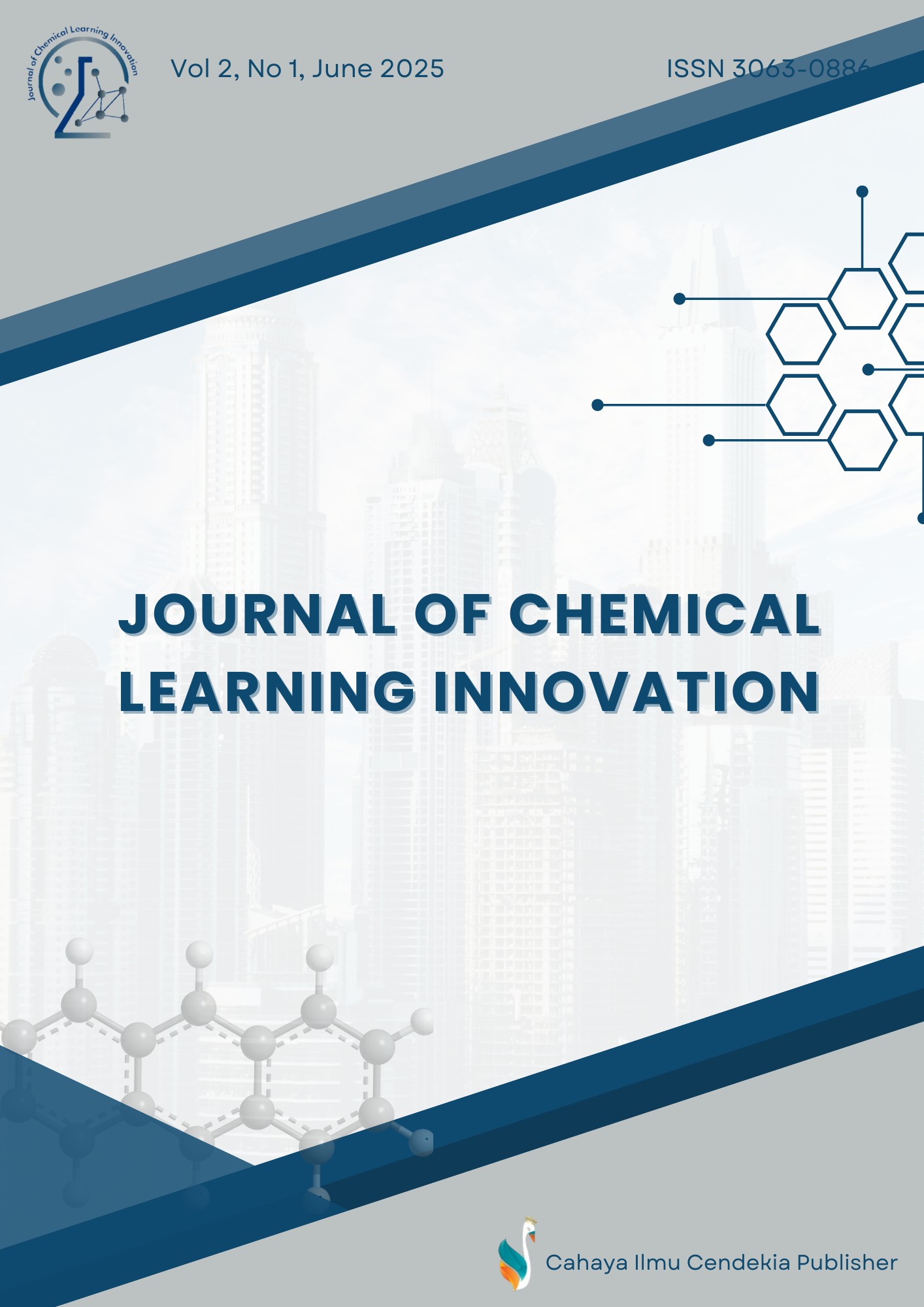Advancing Metal-Air Battery Efficiency: MnO₂ Electrocatalyst Synthesized via Electrochemical Method
Abstract
Purpose of the study: This study investigates the effect of electrode quantity and voltage on MnO₂ nanoparticle yield and characteristics under acidic and basic conditions, while also evaluating MnO₂'s potential as an electrocatalyst in metal-air batteries.
Methodology: Synthesis of MnO₂ was carried out by electrolysis of KMnO₄ solution with stirring using a magnetic stirrer. In acidic conditions, H₂SO₄ was used and the electrolysis process lasted for 30 minutes, while in basic conditions, 0.1 M KOH was used up to pH 9 and electrolysis for 24 hours. The research variables included voltage (2V and 4V) and the number of carbon electrodes (1 pair and 4 pairs). The electrolysis results were separated using a centrifuge, washed with demineralized water, and dried in a furnace.
Main Findings: MnO₂ from electrolysis in acidic conditions tends to have a low crystalline structure, while in basic conditions it is amorphous with a larger surface area. The addition of electrodes and voltage reduces the surface area and increases particle agglomeration. Cyclic voltammetry tests show the ability of MnO₂ to reduce O₂ at all variables, in accordance with the standard oxygen reduction potential. Linear polarization tests show that MnO₂ synthesized in acidic conditions has better electrocatalytic activity than that synthesized in basic conditions.
Novelty/Originality of this study: This study contributes data on the effect of electrolysis parameters on the yield and characteristics of MnO₂ as an electrocatalyst, and shows the best synthesis conditions for application in metal-air batteries.
References
L. Li, Z. Chang, and X. Zhang, “Recent Progress on the Development of Metal‐Air Batteries,” Adv. Sustain. Syst., vol. 1, no. 10, pp. 1–10, Oct. 2017, doi: 10.1002/adsu.201700036.
Q. Sun, L. Dai, T. Luo, L. Wang, F. Liang, and S. Liu, “Recent advances in solid‐state metal–air batteries,” Carbon Energy, vol. 5, no. 2, pp. 1–10, Feb. 2023, doi: 10.1002/cey2.276.
X. Yu and A. Manthiram, “Sustainable Battery Materials for Next‐Generation Electrical Energy Storage,” Adv. Energy Sustain. Res., vol. 2, no. 5, pp. 1–10, May 2021, doi: 10.1002/aesr.202000102.
D. Ahuja, V. Kalpna, and P. K. Varshney, “Metal air battery: A sustainable and low cost material for energy storage,” J. Phys. Conf. Ser., vol. 1913, no. 1, pp. 1–12, 2021, doi: 10.1088/1742-6596/1913/1/012065.
P. Stabile, F. Ballo, G. Mastinu, and M. Gobbi, “An ultra-efficient lightweight electric vehicle—power demand analysis to enable lightweight construction,” Energies, vol. 14, no. 3, pp. 1–18, 2021, doi: 10.3390/en14030766.
D. Golovanov et al., “4-MW Class High-Power-Density Generator for Future Hybrid-Electric Aircraft,” IEEE Trans. Transp. Electrif., vol. 7, no. 4, pp. 2952–2964, 2021, doi: 10.1109/TTE.2021.3068928.
H. Cheng, T. Wang, Z. Li, C. Guo, J. Lai, and Z. Tian, “Anode Interfacial Layer Construction via Hybrid Inhibitors for High-Performance Al–Air Batteries,” ACS Appl. Mater. Interfaces, vol. 13, no. 43, pp. 51726–51735, Nov. 2021, doi: 10.1021/acsami.1c14829.
Q. Li, L. Han, Q. Luo, X. Liu, and J. Yi, “Towards Understanding the Corrosion Behavior of Zinc‐Metal Anode in Aqueous Systems: From Fundamentals to Strategies,” Batter. Supercaps, vol. 5, no. 4, pp. 1–10, Apr. 2022, doi: 10.1002/batt.202100417.
Q. Li et al., “Improving the oxygen redox reversibility of Li-rich battery cathode materials via Coulombic repulsive interactions strategy,” Nat. Commun., vol. 13, no. 1, pp. 1–13, 2022, doi: 10.1038/s41467-022-28793-9.
G. Xu, L. Yang, J. Li, C. Liu, W. Xing, and J. Zhu, “Strategies for improving stability of Pt-based catalysts for oxygen reduction reaction,” Adv. Sens. Energy Mater., vol. 2, no. 2, pp. 1–14, 2023, doi: 10.1016/j.asems.2023.100058.
J. Liu et al., “Rationally Designing Efficient Electrocatalysts for Direct Seawater Splitting: Challenges, Achievements, and Promises,” Angew. Chemie, vol. 134, no. 45, p. e202210753, Nov. 2022, doi: 10.1002/ange.202210753.
F. Guo, T. J. Macdonald, A. J. Sobrido, L. Liu, J. Feng, and G. He, “Recent Advances in Ultralow‐Pt‐Loading Electrocatalysts for the Efficient Hydrogen Evolution,” Adv. Sci., vol. 10, no. 21, pp. 1–23, Jul. 2023, doi: 10.1002/advs.202301098.
C. Das, N. Sinha, and P. Roy, “Transition Metal Non‐Oxides as Electrocatalysts: Advantages and Challenges,” Small, vol. 18, no. 28, p. 2202033, Jul. 2022, doi: 10.1002/smll.202202033.
W. Xiong, H. Yin, T. Wu, and H. Li, “Challenges and Opportunities of Transition Metal Oxides as Electrocatalysts,” Chem. – A Eur. J., vol. 29, no. 5, p. e202202872, Jan. 2023, doi: 10.1002/chem.202202872.
Y. Yao, L. Zhang, Y. Qiu, Z. Li, Z. Ma, and S. Wang, “Phase–activity relationship of MnO2 nanomaterials in periodate oxidation for organic pollutant degradation,” Water Res., vol. 264, p. 122224, Oct. 2024, doi: 10.1016/j.watres.2024.122224.
A. K. Worku, D. W. Ayele, N. G. Habtu, M. A. Teshager, and Z. G. Workineh, “Recent progress in MnO2-based oxygen electrocatalysts for rechargeable zinc-air batteries,” Mater. Today Sustain., vol. 13, p. 100072, Sep. 2021, doi: 10.1016/j.mtsust.2021.100072.
F. Bibi, A. Numan, Y. S. Tan, and M. Khalid, “Facile extraction of Mo2Ti2C3Tx MXene via hydrothermal synthesis for electrochemical energy storage,” J. Energy Storage, vol. 85, p. 111154, Apr. 2024, doi: 10.1016/j.est.2024.111154.
K. Hachem et al., “Methods of Chemical Synthesis in the Synthesis of Nanomaterial and Nanoparticles by the Chemical Deposition Method: A Review,” Bionanoscience, vol. 12, no. 3, pp. 1032–1057, 2022, doi: 10.1007/s12668-022-00996-w.
H. Li et al., “Revisiting the Preparation Progress of Nano‐Structured Si Anodes toward Industrial Application from the Perspective of Cost and Scalability,” Adv. Energy Mater., vol. 12, no. 7, p. 2102181, Feb. 2022, doi: 10.1002/aenm.202102181.
V. Harish et al., “Cutting-edge advances in tailoring size, shape, and functionality of nanoparticles and nanostructures: A review,” J. Taiwan Inst. Chem. Eng., vol. 149, no. March, p. 105010, 2023, doi: 10.1016/j.jtice.2023.105010.
J. Łuczak, M. Kroczewska, M. Baluk, J. Sowik, P. Mazierski, and A. Zaleska-Medynska, “Morphology control through the synthesis of metal-organic frameworks,” Adv. Colloid Interface Sci., vol. 314, no. February, pp. 1–31, 2023, doi: 10.1016/j.cis.2023.102864.
M.-R. Zamani-Meymian, K. Khanmohammadi Chenab, and H. Pourzolfaghar, “Designing High-Quality Electrocatalysts Based on CoO:MnO2@C Supported on Carbon Cloth Fibers as Bifunctional Air Cathodes for Application in Rechargeable Zn–Air Battery,” ACS Appl. Mater. Interfaces, vol. 14, no. 50, pp. 55594–55607, Dec. 2022, doi: 10.1021/acsami.2c16826.
Y. Li et al., “Ultra‐Low Pt Doping and Pt–Ni Pair Sites in Amorphous/Crystalline Interfacial Electrocatalyst Enable Efficient Alkaline Hydrogen Evolution,” Small, vol. 19, no. 23, p. 2300368, Jun. 2023, doi: 10.1002/smll.202300368.
J. Zhang, Y. Li, Z. Chen, Q. Liu, Q. Chen, and M. Chen, “Amorphous Electrode: From Synthesis to Electrochemical Energy Storage,” ENERGY Environ. Mater., vol. 6, no. 6, p. e12573, Nov. 2023, doi: 10.1002/eem2.12573.
Y. Zhang, D. Wang, C. Ye, F. Gao, Z. Li, and Y. Du, “Regulation of crystallinity and defects on CoNiRuOx nanocages for enhanced oxygen evolution reaction,” Chem. Eng. J., vol. 466, p. 143059, Jun. 2023, doi: 10.1016/j.cej.2023.143059.
Y. Chen et al., “Molecular Engineering toward High‐Crystallinity Yet High‐Surface‐Area Porous Carbon Nanosheets for Enhanced Electrocatalytic Oxygen Reduction,” Adv. Sci., vol. 9, no. 3, p. 2103477, Jan. 2022, doi: 10.1002/advs.202103477.
X. Yi, Y. Song, D. He, W. Li, A. Pan, and C. Han, “Constructing a high-performance bifunctional MnO 2 -based electrocatalyst towards applications in rechargeable zinc–air batteries,” J. Mater. Chem. A, vol. 12, no. 43, pp. 29355–29382, 2024, doi: 10.1039/D4TA05182C.
M. Karimpour, M. Dorri, A. Babaei, C. Zamani, M. Soleimani, and M. Pourfath, “New insights on the effects of surface facets and calcination temperature on electrochemical properties of MnCo2O4 as bifunctional oxygen electrocatalyst in zinc-air batteries,” Electrochim. Acta, vol. 467, p. 143022, Nov. 2023, doi: 10.1016/j.electacta.2023.143022.
Y.-Y. Lee et al., “Recent Advances in Electrocatalytic Transesterification: Enhancing Biodiesel Synthesis for Sustainable Energy,” Int. J. Energy Res., vol. 2025, no. 1, p. 7887020, Jan. 2025, doi: 10.1155/er/7887020.
R. Kulkarni et al., “Exploring the recent cutting-edge applications of CNTs in energy and environmental remediation: Mechanistic insights and remarkable performance advancements,” J. Environ. Chem. Eng., vol. 12, no. 5, p. 113251, Oct. 2024, doi: 10.1016/j.jece.2024.113251.
L. Zeng, G. Zhang, X. Huang, H. Wang, T. Zhou, and H. Xie, “Tuning crystal structure of MnO2 during different hydrothermal synthesis temperature and its electrochemical performance as cathode material for zinc ion battery,” Vacuum, vol. 192, p. 110398, Oct. 2021, doi: 10.1016/j.vacuum.2021.110398.
A. Tounsi et al., “One-step electrochemical synthesis of FTO/MnO2-graphene composite for electrochemical energy storage,” J. Energy Storage, vol. 73, p. 109228, Dec. 2023, doi: 10.1016/j.est.2023.109228.
Z. Lin, S. Cheng, Z. Yu, J. Yang, H. Huang, and Y. Sun, “Enhancing bio-cathodic nitrate removal through anode-cathode polarity inversion together with regulating the anode electroactivity,” Sci. Total Environ., vol. 764, p. 142809, Apr. 2021, doi: 10.1016/j.scitotenv.2020.142809.
A. A. Samkov et al., “Decolorization of Dyes in a Bioelectrochemical System Depending on the Immobilization of Shewanella oneidensis Mr-1 Cells on the Anode Surface and Electrical Stimulation of an External Circuit,” Appl. Biochem. Microbiol., vol. 59, no. 2, pp. 198–205, Apr. 2023, doi: 10.1134/S0003683823020096.
K.-J. Wu, E. C. M. Tse, C. Shang, and Z. Guo, “Nucleation and growth in solution synthesis of nanostructures – From fundamentals to advanced applications,” Prog. Mater. Sci., vol. 123, p. 100821, Jan. 2022, doi: 10.1016/j.pmatsci.2021.100821.
P. Sharma, P. Parashar, D. Ghosh, D. Yadav, P. Rawat, and S. Majumder, “A Review on Microwave Assisted Synthesis of Transition Metal Oxides and their Potent Application as Supercapacitors,” ChemistrySelect, vol. 8, no. 47, p. e202303467, Dec. 2023, doi: 10.1002/slct.202303467.
Z. Liu et al., “Ion migration and defect effect of electrode materials in multivalent-ion batteries,” Prog. Mater. Sci., vol. 125, p. 100911, Apr. 2022, doi: 10.1016/j.pmatsci.2021.100911.
Y.-D. Dong et al., “Synthesis of Fe–Mn-Based Materials and Their Applications in Advanced Oxidation Processes for Wastewater Decontamination: A Review,” Ind. Eng. Chem. Res., vol. 62, no. 28, pp. 10828–10848, Jul. 2023, doi: 10.1021/acs.iecr.3c01624.
L. Hao, J. H. Yang, G. Li, P. Li, and Y. Cao, “Development and challenges of coal-based graphene family nanomaterials,” Rev. Inorg. Chem., pp. 1–25, 2025, doi: 10.1515/revic-2024-0101.
A. M. Butt, M. Batool, M. A. Jaoude, and A. Qurashi, “Recent advancement in manganese-based electrocatalyst for green hydrogen production,” J. Electroanal. Chem., vol. 937, p. 117393, May 2023, doi: 10.1016/j.jelechem.2023.117393.
Copyright (c) 2025 Giska Koesumasari Putri

This work is licensed under a Creative Commons Attribution 4.0 International License.
Authors who publish with this journal agree to the following terms:
- Authors retain copyright and acknowledge that the Journal of Chemical Learning Innovation is the first publisher licensed under a Creative Commons Attribution 4.0 International License.
- Authors are able to enter into separate, additional contractual arrangements for the non-exclusive distribution of the journal's published version of the work (e.g., post it to an institutional repository or publish it in a book), with an acknowledgment of its initial publication in this journal.
- Authors are permitted and encouraged to post their work online (e.g., in institutional repositories or on their website) prior to and during the submission process, as it can lead to productive exchanges and earlier and greater citation of published work.





.png)
.png)










